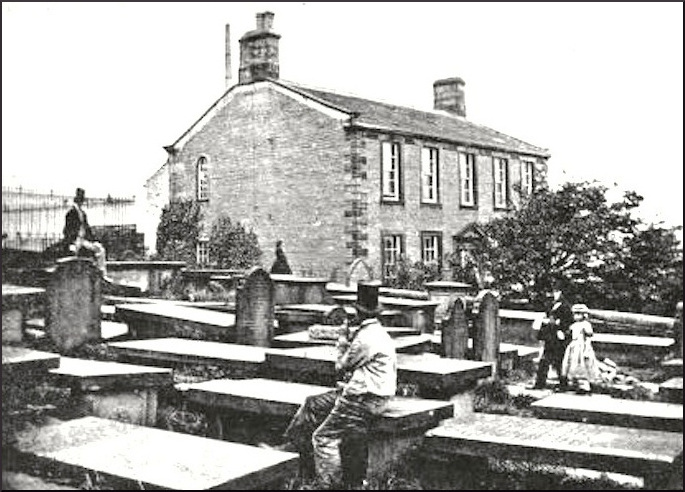
Haworth Parsonage, from a photograph taken in Charlotte Brontë's time (Wood, facing p.16). Mrs Gaskell, who visited it in September 1853, described its situation and outer aspect in the following passages:
The parsonage stands at right angles to the road, facing down upon the church; so that, in fact, parsonage, church, and belfried schoolhouse form three sides of an irregular oblong, of which the fourth is open to the fields and moors that lie beyond. The area of this oblong is filled up by a crowded churchyard, and a small garden or court in front of the clergyman's house. As the entrance to this from the road is at the side, the path goes round the corner into the little plot of ground. Underneath the windows is a narrow flower-border, carefully tended in days of yore, although only the most hardy plants could be made to grow there. Within the stone wall, which keeps out the surrounding churchyard, are bushes of elder and lilac; the rest of the ground is occupied by a square grass — plot and a gravel walk. The house is of grey stone, two stories high, heavily roofed with flags, in order to resist the winds that might strip off a lighter covering. It appears to have been built about a hundred years ago [near enough then: it was built in 1779 (Barker 99)], and to consist of four rooms on each story; the two windows on the right (as the visitor stands with his back to the church, ready to enter in at the front door) belonging to Mr. Brontë's study, the two on the left to the family sitting-room. Everything about the place tells of the most dainty order, the most exquisite cleanliness. The doorsteps are spotless; the small old-fashioned window-panes glitter like looking-glass. Inside and outside of that house cleanliness goes up into its essence, purity.
The church lies, as I mentioned, above most of the houses in the village ; and the graveyard rises above the church, and is terribly full of upright tombstones. [4-5]
As to its interior, Mrs Gaskell wrote:
The house consists of four rooms on each floor, and is two stories high. When the Brontës took possession they made the larger parlour, to the left of the entrance, the family sitting-room, while that on the right was appropriated to Mr. Bronte as a study. Behind this was the kitchen; behind the former, a sort of flagged store room. Upstairs were four bed-chambers of similar size, with the addition of a small apartment over the passage, or "lobby," as we call it in the north. This was to the front, the staircase going up right opposite to the entrance. There is the pleasant old fashion of window seats all through the house; and one can see that the parsonage was built in the days when wood was plentiful, as the massive stair banisters, and the wainscots, and the heavy window frames testify.
This little extra upstairs room was appropriated to the children. Small as it was, it was not called a nursery; indeed, it had not the comfort of a fireplace in it; the servants — two affectionate, warm-hearted sisters, who cannot now speak of the family without tears — called the room the "children's study." The age of the eldest student was perhaps by this time seven. [48-49]
Mrs Gaskell adds in a note that "the 'flagged store room' was converted into a study for Mr. Nicholls during liis brief married life" (49).
Image scan and text by Jacqueline Banerjee. You may use this image without prior permission for any scholarly or educational purpose as long as you (1) credit the photographer or person who scanned the image, and (2) link your document to this URL in a web document or cite it in a print one. [Clicking on this image will take you to a review of The Brontës in Context (2012), ed. Marianne Thormählen, in which this image first appeared.]
Bibliography
Barker, Juliet. The Brontës. London: Weidenfeld and Nicolson, 1994.
Gaskell, Elizabeth Cleghorn. The Life of Charlotte Brontë. New York and London: Harper & Bros., 1900. Internet Archive. Contributed by the Library of Congress. Web. 3 December 2017.
Wood, Butler, ed. Charlotte Brontë, 1816-1916; a centenary memorial, prepared by the Brontë society, with a foreword by Mrs. Humphry Ward and 3 maps and 28 illustrations. New York: Dutton, 1918. Internet Archive. Contributed by University of California Libraries. Web. 3 December 2017.
Created 2 December 2017